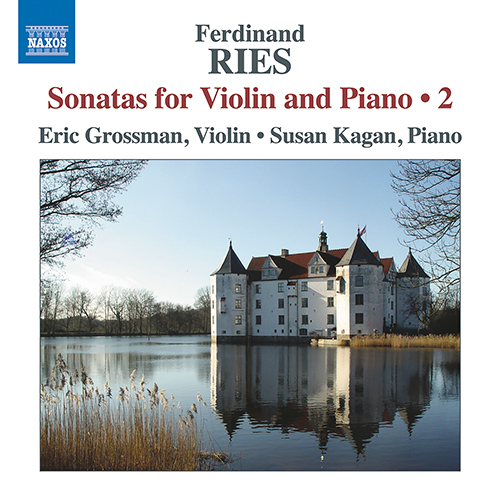I reviewed the first volume in this series…and at the time I stated, “This is awfully good music to be sitting around unrecorded for so long, and one wonders if the remaining sonatas are as attractive as these.” Wonder no longer: This is Volume 2, and it is just as attractive.
As on the first disc, Grossman and Kagan are fine advocates for this music, emphasizing its domestic charms, perhaps at the expense of brilliance and dash. In the A-Minor Sonata, for example, I’d hardly call the first movement an Allegro molto or the finale a Presto, and I suspect there are plenty of other performers who would drive this music harder. I might even like those results, but I have to say that the controlled and level-headed performances offered here satisfied me in much the same way that I am satisfied when I return home from work and put on a pair of comfortable shoes. High fashion? No, but Ries’s chamber music seems to respond to Grossman’s and Kagan’s intimate and friendly playing. And, as before, Kagan’s knowledgeable booklet note adds to one’s enjoyment. As before, this is unreservedly recommended. © 2018 Fanfare Read complete review
Ferdinand Ries is usually only mentioned in the same breath as Beethoven, for whom he was friend, pupil, amanuensis, go-between and more, so it’s worthwhile to be able to hear some of his own music. Don’t expect the pyrotechnics of the elder composer’s ‘Kreutzer’ or the ecstatic melodies of his op. 96 though: the B flat major Sonata (1806) is very much in the vein of Mozart’s accompanied sonata style and becomes bogged down in clichéd piano figures—at least until the polonaise finale, which finally admits a degree of virtuosity to help power the argument.
The two minor-key sonatas of five years later come closer to the Beethovenian ideal, with their more advanced writing for both instruments and an array of agitated figures driving the drama. Eric Grossman (a student of Dorothy DeLay) and Susan Kagan play them decently enough, with only one or two minor squeaks that might have been retaken, although perhaps Kagan comes over a little reticent, draining the last ounce of character from the important lines for piano (Ries’s own instrument, on which he was something of a virtuoso). The balance between the two instruments seems ideal in this close-ish recording. Fascinating for those eager to discover the milieu over which the mighty Beethoven towered. © 2017 The Strad
Largely self-taught in composition, Ferdinand Ries became the favourite piano pupil of Beethoven, but it was in London that he settled and secured a major career. Adopting him as the nation’s finest and most popular pianist-composer of his time, he had already created a large library of works before he arrived, and that included eighteen violin sonatas. In style and content they owed a great deal to the influences of Mozart, but he was a composer of a extreme variability, and here, while admiring him as a competent ‘kapellmeister’, he was rather lacking in melodic invention, the second of his opus 16, from his twenty-second year in 1806, dutifully trundling along until we reach the final Polonaise which has a degree of vivacity. Five years later, his two opus 38 sonatas have much greater substance and an element of drama mixed with joy in the outer movements of the first sonata surrounding a thoughtful slow central Larghetto. The second of the opus is unusual in having a central movement in the form of variations on a simple theme stated by the piano, the final dramatic Presto, taking its inspiration from Beethoven, having the piano stoking-up impending doom with a left hand tremolo, and while Ries writes well for the violin, you are always more than aware that his main instrument was the piano. This is the second volume in the promised cycle of the complete sonatas, the pianist, Susan Kagan, a champion of the composer, being joined by the American violinist, Eric Grossman. Would a wider dynamic range in his playing have helped Ries? Reliable sound quality. © 2017 David’s Review Corner
Models of Viennese Classical style, these sonatas date from 1806 and 1811 and the earlier one has a rare obvious reference to Beethoven in its first movement—the famous motto theme of the Fifth Symphony. © 2017 Records International
































